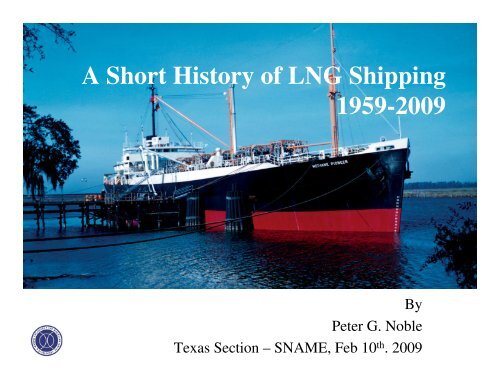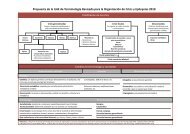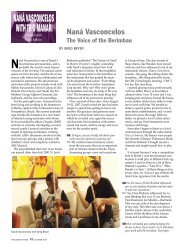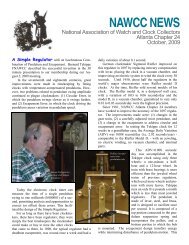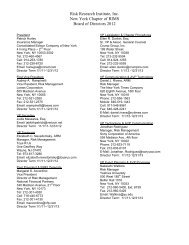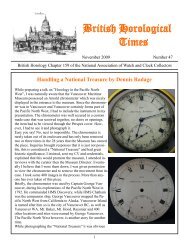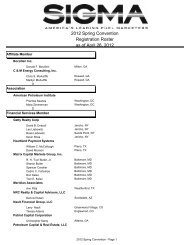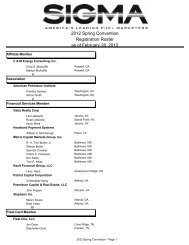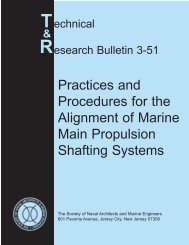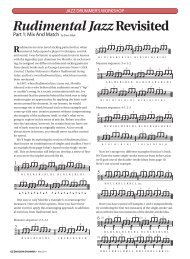A Short History of LNG Shipping 1959-2009 - Amazon Web Services
A Short History of LNG Shipping 1959-2009 - Amazon Web Services
A Short History of LNG Shipping 1959-2009 - Amazon Web Services
Create successful ePaper yourself
Turn your PDF publications into a flip-book with our unique Google optimized e-Paper software.
A <strong>Short</strong> <strong>History</strong> <strong>of</strong> <strong>LNG</strong> <strong>Shipping</strong><br />
<strong>1959</strong>-<strong>2009</strong><br />
By<br />
Peter G. Noble<br />
Texas Section – SNAME, Feb 10 th . <strong>2009</strong>
• On January 25 th <strong>1959</strong>, the MV<br />
Methane Pioneer left the<br />
Calcasieu River on the<br />
Louisiana Gulf coast with the<br />
world’s first ocean cargo <strong>of</strong><br />
<strong>LNG</strong> and sailed to the UK<br />
where the <strong>LNG</strong> was delivered<br />
• Subsequent expansion <strong>of</strong> that<br />
trade has brought us to today<br />
when giant <strong>LNG</strong> ships carrying<br />
up to 266,000 m3 <strong>of</strong> cargo are<br />
entering service.<br />
• SNAME and SNAME members<br />
have been an integral part <strong>of</strong><br />
this half century <strong>of</strong><br />
development and this<br />
presentation will highlight some<br />
key events<br />
Introduction<br />
M.V. Methane Pioneer Loading <strong>LNG</strong><br />
Canvey Island Receiving Terminal, UK
What is <strong>LNG</strong><br />
• Liquefied natural gas or <strong>LNG</strong> is natural gas (primarily methane, CH4)<br />
that has been converted to liquid form for ease <strong>of</strong> storage or transport.<br />
• When natural gas is cooled to below its liquefaction point <strong>of</strong> about<br />
minus163 degrees Celsius at atmospheric pressure, it forms a liquid with a<br />
specific gravity in the 0.45 range.<br />
• When liquefied there is a 600:1 reduction in volume<br />
• <strong>LNG</strong> is normally stored in insulated tanks at atmospheric pressure and<br />
typically boils slowly giving <strong>of</strong>f about 0.10% – 0.15% <strong>of</strong> volume per day in<br />
the form <strong>of</strong> Boil-Off Gas, BOG.<br />
• Michael Faraday was the first to experiment with liquefaction <strong>of</strong> methane<br />
in the mid-nineteenth century.<br />
• The first <strong>LNG</strong> plant built in West Virginia in 1912. It began operation in<br />
1917<br />
• The first commercial liquefaction plant was built in Cleveland, Ohio, in<br />
1941 for storage <strong>of</strong> natural gas
Some Background Statistics on<br />
<strong>LNG</strong> <strong>Shipping</strong> Business
Source: www.coltoncompany.com<br />
Current <strong>LNG</strong> Fleet Size<br />
January 15 th <strong>2009</strong><br />
Summary<br />
Type Size Bracket<br />
In Service<br />
Pre-<strong>2009</strong> <strong>2009</strong> Total <strong>2009</strong><br />
Building for Delivery in<br />
2010 2011 2012 2013 Total<br />
Totals<br />
Q-Max > 250,000 cm 4 0 4 8 2 0 0 0 10 14<br />
Q-Flex 200-250,000 cm 20 0 20 6 4 0 0 0 10 30<br />
Standard 100-200,000 cm 244 0 244 28 16 13 2 0 59 303<br />
Small
<strong>LNG</strong> Ships withdrawn from service<br />
January 15, <strong>2009</strong><br />
Name <strong>of</strong> Ship Operator Shipbuilder<br />
Year Built<br />
or Rebuilt<br />
# <strong>of</strong><br />
Voyages<br />
Year Withdrawn<br />
Cargo<br />
Capacity<br />
(cu.m.)<br />
Cargo<br />
System Disposition<br />
Methane (barge) Chicago Stockyards Ingalls 1955 0 1955 5,550 Morrison Converted to an oil barge<br />
Beauvais Gaz de France Atlantique 1962 0 1962 640 Mixed Scrapped<br />
Pythagore Gazocean Le Havre 1964 1 1964 610 TZM Converted to a fish carrier<br />
Aristotle (ex Methane Pioneer) Stephenson, Clarke Alabama 1958 30 1972 5,000 Morrison Converted to LPG storage<br />
Euclides Gazocean Le Havre 1971 14 1973 4,000 TZM Converted to an LPG carrier<br />
Sanko Ethylene Maru Hitachi Zosen Hitachi 1974 0 1974 1,100 Hitachi Disposition unknown<br />
Massachusetts (barge) Unknown Todd Houston 1974 7 1974 4,000 Unknown Converted to LPG storage<br />
Sant Jordi Unknown Bilbao 1975 0 1975 5,000 Sener Sank <strong>of</strong>f Spain in 1995<br />
El Paso Columbia El Paso Tankers Avondale 1979 0 1979 130,000 Conch Converted to OBO, scrapped in 2000<br />
El Paso Savannah El Paso Tankers Avondale 1979 0 1979 130,000 Conch Converted to OBO, now an FPSO<br />
El Paso Cove Point El Paso Tankers Avondale 1979 0 1979 130,000 Conch Wrecked and scrapped in 1987<br />
Ben Franklin SNTM-Hyproc La Ciotat 1975 5 1980 120,000 TZM Scrapped in 1980<br />
El Paso Paul Keyser El Paso Tankers Dunkerque 1976 12 1980 129,500 GT Scrapped in 1985<br />
El Paso Sonatrach El Paso Tankers Dunkerque 1977 26 1980 129,500 GT Scrapped in 1985<br />
El Paso Consolidated El Paso Tankers Dunkerque 1977 15 1980 129,500 GT Scrapped in 1987<br />
Esso Portovenere SNAM Italcantieri 1971 335 1984 40,000 Esso Scrapped in 1984<br />
Methane Progress British Gas Harland & Wolff 1964 467 1992 27,400 Conch Scrapped in 1992<br />
Methane Princess British Gas Vickers-Armstrong 1964 500+ 1998 27,400 Conch Scrapped in 1998<br />
Havfru BW Gas Moss Verft 1973 7-May 29,388 Moss Scrapped in 2007<br />
Laieta Maritima del Norte Astano 1970 8-Jun 40,000 Esso Scrapped in 2008<br />
Cinderella TMT Co. Ltd. Le Trait 1965 8-Jul 25,500 Worms Scrapped in 2008<br />
Charm Junior TMT Co. Ltd. Atlantique 1971 8-Jul 50,000 TZ Mk. 1 Scrapped in 2008<br />
Century BW Gas Moss Verft 1974 8-Nov 29,588 Moss Scrapped in 2008
Growth in Capacity <strong>of</strong> <strong>LNG</strong> Carriers<br />
New “Super-sized” <strong>LNG</strong>Cs in the range <strong>of</strong> 210,000m3 to<br />
266,000m3 now under construction and entering service<br />
for long haul projects<br />
“Standard” sized <strong>LNG</strong>Cs have grown from<br />
~125,000m3 to ~155,000m3 over past 40 years
<strong>History</strong> <strong>of</strong> <strong>LNG</strong> Transport at Sea
Beginnings <strong>of</strong> Waterborne <strong>LNG</strong><br />
• In the mid 1950s, an early concept for the transportation and use <strong>of</strong><br />
<strong>LNG</strong> was explored, by Union Stockyards, Chicago and Continental<br />
Oil through a joint venture named Constock.<br />
• The plan was to buy gas on the Gulf Coast, liquefy it, transport by<br />
water to Chicago, and vaporize it in the food processing industry,<br />
using the cold for refrigeration and making the gas available for<br />
industrial use.<br />
• As part <strong>of</strong> this venture a barge, the Methane with a cargo capacity <strong>of</strong><br />
5,550 cubic meters, was built at Ingalls Shipyard to operate on the<br />
Mississippi hauling <strong>LNG</strong> north to Chicago.<br />
• The initial economics looked good, however the FDA refused to<br />
permit the concept down due to the fear <strong>of</strong> contaminating the food<br />
product.<br />
• The failure to obtain approval from FDA caused Union Stockyards<br />
to withdraw from the venture. .
<strong>LNG</strong> Ocean <strong>Shipping</strong> - The Start<br />
• Continental chose to continue the <strong>LNG</strong> operation and<br />
found that gas could be liquefied on the Gulf coast,<br />
transported to the east Coast by water, vaporized and<br />
put into the gas mains competitively with pipelining.<br />
• In the late 1950’s an opportunity to sell <strong>LNG</strong> to the<br />
UK developed and Constock aligned itself with the<br />
British Gas Council to develop the world’s first ocean<br />
shipping system for <strong>LNG</strong>
M.V. Methane Pioneer - <strong>1959</strong><br />
• On January 25 th <strong>1959</strong>, the MV<br />
Methane Pioneer left the Calcasieu<br />
River on the Louisiana Gulf coast<br />
with the world’s first ocean cargo <strong>of</strong><br />
<strong>LNG</strong> and sailed to the UK where the<br />
<strong>LNG</strong> was delivered<br />
• In 1968 the Methane Pioneer became<br />
the first <strong>LNG</strong> ship to import cargoes<br />
into the US, when its cargo was<br />
<strong>of</strong>floaded in Boston Harbor into <strong>LNG</strong><br />
trucks positioned on a barge.<br />
• The Methane Pioneer became the first<br />
<strong>LNG</strong> ship to be diesel powered and<br />
the first to <strong>of</strong>fload at sea –<br />
innovations which we will see are <strong>of</strong><br />
current interest.
Outline Specifications MV Methane Pioneer<br />
• Ship was originally built as a US<br />
Government cargo ship, a C1-M-AV1<br />
design, at end <strong>of</strong> WWII.<br />
• The M.V. Marline Hitch was built in<br />
Duluth, MN and delivered in July<br />
1945<br />
• The vessel was converted to carry<br />
<strong>LNG</strong> in 1958.<br />
• MV Methane Pioneer Specifications<br />
– Length O.A 338.5 ft<br />
– Beam 50.0 ft<br />
– Draft 18.0 ft<br />
– Deadweight. 5034 tons<br />
– <strong>LNG</strong> Cargo Capacity ~5000 m3<br />
– Power (diesel) 1750 h.p<br />
M.V. Marline Hitch – C1-M-AV1<br />
M.V. Methane Pioneer Conversion
First purpose built <strong>LNG</strong> ship -<br />
• The success <strong>of</strong> the Methane Pioneer<br />
caused Shell to order two purpose<br />
built <strong>LNG</strong> carriers to be constructed<br />
in the UK;<br />
– the Methane Princess at Vickers<br />
Armstrong and<br />
– the Methane Progress at Harland and<br />
Wolff<br />
• The ships were fitted with Conch<br />
independent aluminum cargo tanks<br />
and entered the Algerian <strong>LNG</strong> trade<br />
in 1964.<br />
• These ships had a capacity <strong>of</strong> ~27,000<br />
cubic meters <strong>of</strong> cargo and between<br />
them made ~1,000 voyages before<br />
being scrapped in the mid 1990s<br />
Methane Princess<br />
S.T. Methane Princess<br />
Principle Dimensions<br />
Length:<br />
Beam:<br />
Installed<br />
power:<br />
Propulsion:<br />
Speed:<br />
621 ft (189 m)<br />
82 ft (25 m)<br />
13750 shp<br />
Steam<br />
17.5 knots
Kenai, Alaska <strong>LNG</strong> Export<br />
• In the late 1960s and<br />
opportunity arose to export<br />
<strong>LNG</strong> from Alaska to Japan and<br />
in 1969 that trade was initiated.<br />
• Two ships, each with a capacity<br />
<strong>of</strong> 71,500 cubic meters were<br />
built at the Kockums yard in<br />
Sweden. While the shipyard is<br />
long gone, these ships remain<br />
in service with SovComFlot as<br />
the SCF Polar and SCF Arctic<br />
and are currently in the<br />
Trinidad to Spain trade<br />
<strong>LNG</strong> Ship - SCF Arctic<br />
<strong>LNG</strong> Ship - SCF Polar
US <strong>LNG</strong>C Shipbuilding<br />
• In the early 1970’s the US Government encouraged<br />
US shipyards to build <strong>LNG</strong>Cs by providing loan<br />
guarantees through MarAd Title XI<br />
• Three shipyards took up this challenge with varying<br />
degrees <strong>of</strong> success<br />
• A total <strong>of</strong> 16 <strong>LNG</strong> ships were built<br />
– General Dynamics, Quincy – 10 ships using the Moss<br />
spherical tank system<br />
– Newport News, VA – 3 ships using the TZ Mk 1 system<br />
– Avondale, LA – 3 ships using a modified Conch System
Energy Transport Corp.<br />
• Energy Transportation Corporation<br />
took delivery <strong>of</strong> 8 <strong>of</strong> the 125,000 m3<br />
GD built ships and placed them into<br />
long term charter with Burmah Oil<br />
Company delivering <strong>LNG</strong> from<br />
Indonesia to Japan.<br />
• The ships were originally US Flag<br />
with US crews, but recently have<br />
transferred to Marshall Islands Flag.<br />
They remain in the Indonesian <strong>LNG</strong><br />
trade.<br />
– Delivered Sept 1978<br />
– Cargo Capacity 126,300 m3<br />
– Power (steam) 43,000 s.h.p.<br />
– Service Speed 20.4 knots<br />
<strong>LNG</strong> ship Gemini<br />
<strong>LNG</strong> ship Aquarius
El Paso - Newport News Ships<br />
• Newport News delivered 3<br />
membrane <strong>LNG</strong> ships to El<br />
Paso in 1978-79.<br />
• These ships are still in<br />
service with the following<br />
operators and trades:<br />
– <strong>LNG</strong> Delta – Operator, Shell<br />
STASCO – Service Nigeria-<br />
Europe<br />
– Galeomma – Operator, Shell<br />
STASCO – Service, Oman-<br />
Spain<br />
– Suez Mathew – Operator,<br />
Hoegh <strong>LNG</strong>– Service,<br />
Trinidad - US<br />
<strong>LNG</strong> Ship - <strong>LNG</strong> Delta<br />
<strong>LNG</strong> Ship - Galeomma<br />
<strong>LNG</strong> Ship – Suez Matthew
El Paso – Avondale Ships<br />
• The El Paso ship project at Avondale turned into a fiasco.<br />
• The ships were built with a modified Conch system using independent<br />
aluminum tanks with a novel insulation system<br />
• The ships had a length <strong>of</strong> 931.5 ft; a beam <strong>of</strong> 140.5 ft; and a draft <strong>of</strong> 36<br />
ft. Cargo tank capacity was 125,000 cubic meter and the single screw<br />
steam turbine plant developed 41,000 shaft horsepower..<br />
• When undergoing builder’s trials the cargo tank insulation failed and<br />
when it was determined that repairs could not be effectively made, the<br />
ships were declared total constructive losses.<br />
• The disposition <strong>of</strong> the ships was as follows<br />
– El Paso Columbia – converted to OBO ship, scrapped in 2000<br />
– El Paso Savannah – converted to OBO, then converted to double hulled<br />
FSO for N. Sea. Still in service<br />
– El Paso Cove Point – wrecked and scrapped in 1987
Arctic Pilot Program – <strong>LNG</strong><br />
• The late 1970s and early1980’s<br />
brought the prospect <strong>of</strong> Arctic<br />
<strong>LNG</strong> ships with a number <strong>of</strong><br />
projects being studied.<br />
• The Arctic Pilot Program led by<br />
PetroCanada was one <strong>of</strong> the<br />
leading projects with plans to build<br />
a liquefaction plant at Bridport<br />
Inlet on the south coast <strong>of</strong> Melville<br />
Island in the Canadian Arctic<br />
islands and to ship <strong>LNG</strong> in<br />
icebreaking <strong>LNG</strong>Cs through the<br />
N.W. Passage to eastern Canada.<br />
• Significant work was done on this<br />
project before the lower energy<br />
prices <strong>of</strong> the mid 1980s put the<br />
project on the shelf.<br />
Artist’s Impression – Icebreaking <strong>LNG</strong> ship<br />
Arctic Pilot Project <strong>Shipping</strong> Route
New Ships for Kenai Trade - 1995<br />
• In 1995, the Kenai <strong>LNG</strong> project<br />
replaced the original Swedish<br />
built ships with two somewhat<br />
larger capacity ships, (89,880<br />
cubic meters) built by IHI in<br />
Japan.<br />
• The ships are steam turbine<br />
driven with and installed power<br />
<strong>of</strong> 21,000 h.p. giving a service<br />
speed <strong>of</strong> 18.5 knots<br />
• The ships, the Polar Eagle and<br />
Arctic Sun, are unique in that<br />
they employ free-standing<br />
prismatic cargo tanks - so far<br />
the only ships in service with<br />
this arrangement.
Dual Fuel Diesel Electric <strong>LNG</strong> Ships<br />
• Traditional <strong>LNG</strong> ships have had<br />
steam turbine plant installed and<br />
have used the boil <strong>of</strong> gas, BOG as<br />
a fuel source for the boilers along<br />
with heavy fuel as required.<br />
• In recent years medium speed<br />
diesel engine technology has been<br />
advanced so that these units can<br />
now run on dual fuels – gas or<br />
liquid.<br />
• The schematic shows a typical;<br />
arrangement for a DFDE ship with<br />
4 diesel generator sets, feeding two<br />
motors connected to a single<br />
propeller through a gearbox.<br />
• Depending on the service it is<br />
possible to use prime movers <strong>of</strong><br />
different size to optimize<br />
performance, both in terms <strong>of</strong> fuel<br />
consumption and air emissions<br />
DFDE <strong>LNG</strong> Ship British Emerald
• Another relative new development has<br />
been the Regas Transport <strong>LNG</strong> ship,<br />
promoted by Excellerate Energy and<br />
using the APL submerged turret<br />
loading systems<br />
• In addition to their cargo tanks these<br />
ships are fitted with vaporization<br />
equipment and submerged turret<br />
loading such that <strong>LNG</strong> cargo can be<br />
turned back into natural gas and then<br />
exported to new or existing <strong>of</strong>fshore<br />
pipelines for onward transport to<br />
market.<br />
• It is also possible to use these type <strong>of</strong><br />
ships as <strong>of</strong>fshore storage units with<br />
ship-to-ship transfer taking place<br />
between the transport ship and the<br />
storage ship<br />
Re-Gas Ships
Q-Flex & Q-Max <strong>LNG</strong>Cs<br />
• Qatargas has pioneered the development <strong>of</strong> two new classes <strong>of</strong> Liquefied Natural<br />
Gas (<strong>LNG</strong>) tankers. Referred to as Q-Flex and Q-Max. Each ship has a cargo<br />
capacity <strong>of</strong> between 210,000 and 266,000 cubic meters.<br />
• These new vessels have many innovative features to maximize cargo deliveries and<br />
to ensure the highest levels <strong>of</strong> safety and reliability, some <strong>of</strong> which include:<br />
– Twin engines and shafts to ensure maximum propulsion safety and reliability, with<br />
reduced environmental footprint and twin rudders to ensure safety <strong>of</strong> navigation and<br />
maneuverability in confined waters.<br />
– Slow speed diesel engines which are more thermally efficient than steam turbines and<br />
therefore burn less fuel, which will produce 30% lower overall emissions compared to<br />
traditional existing <strong>LNG</strong> carriers.<br />
– Cargo re-liquefaction plants will return cargo boil <strong>of</strong>f to the cargo tanks and therefore<br />
maximize the cargo delivery at the discharge port.<br />
• The vessels are currently being constructed at three shipyards in South Korea:<br />
Hyundai Heavy Industries (HHI) at Ulsan, Samsung Heavy Industries (SHI) on<br />
Geoje Island and Daewoo Shipbuilding & Marine Engineering (DSME), also on<br />
Geoje Island.
QatarGas <strong>LNG</strong> Ships at DSME, Korea<br />
2244<br />
2244<br />
2247 2247<br />
2247<br />
2245<br />
2245<br />
2246<br />
2246<br />
2250<br />
2250<br />
2243 2243<br />
2243<br />
2249<br />
2249<br />
2248<br />
2248<br />
1 Dock In No 1 Dock In No 1 Dock In No 1 Dock No In<br />
May 2007
QatarGas <strong>LNG</strong> Ships at DSME, Korea<br />
Comparison <strong>of</strong> “standard” sized <strong>LNG</strong> ~145,000m3 with<br />
“super-sized” <strong>LNG</strong> ~210,000+ m3
Lead Ship Q-Max Class 266,000m3<br />
Lead Q-Max “MOZAH”<br />
alongside outfit berth,<br />
Samsung Heavy Industries.<br />
Geoje Island, Korea<br />
Lead Q-Max “MOZAH”<br />
returning from Sea Trails
Harsh Environment <strong>LNG</strong> <strong>Shipping</strong><br />
• An number <strong>of</strong> high<br />
latitude – harsh<br />
environment <strong>LNG</strong><br />
projects are already<br />
underway and more<br />
will come in the<br />
future<br />
– Kenai – started<br />
shipping in 1969<br />
– Snohvit – started<br />
shipping in 2007<br />
– Sakhalin – will start<br />
shipping in <strong>2009</strong><br />
<strong>LNG</strong> Ship alongside Kenai Dock<br />
Arctic Princess leaves Hamarfest<br />
with 1st. <strong>LNG</strong> Cargo from Snohvit<br />
<strong>LNG</strong> Ship alongside Sakhalin Dock
Cargo Containment System Usage
Membrane Tank Construction<br />
Build a double hulled ship mid-body and start to<br />
scaffold the tanks<br />
Complete scaffolding <strong>of</strong> the cargo holds to access<br />
the whole inner surface <strong>of</strong> the tank
Membrane Tank Construction<br />
Complete installation <strong>of</strong> membrane system and install<br />
cantilevered pump mast<br />
continued<br />
Completed tank with pump mast installed
Conclusions<br />
• Natural gas is the fuel <strong>of</strong> choice for many applications and its<br />
increasing popularity will keep the demand for efficient<br />
shipping high.<br />
• Large <strong>LNG</strong> ships are here to stay, although the increasing size<br />
<strong>of</strong> <strong>LNG</strong> ships may have already reached a natural limit, at least<br />
for the time being based on current infrastructure and markets.<br />
• We will continue to see developments in improved <strong>LNG</strong><br />
containment systems, and propulsion systems.<br />
• New projects with particularly challenging conditions such as<br />
shipping <strong>LNG</strong> from the Russian and Canadian Arctic will<br />
provide exciting challenges for naval architects, marine<br />
engineers and shipbuilders in the years ahead.
Questions?<br />
Methane Pioneer in Louisiana, loading first cargo <strong>of</strong> <strong>LNG</strong> bound<br />
for UK, January <strong>1959</strong>


